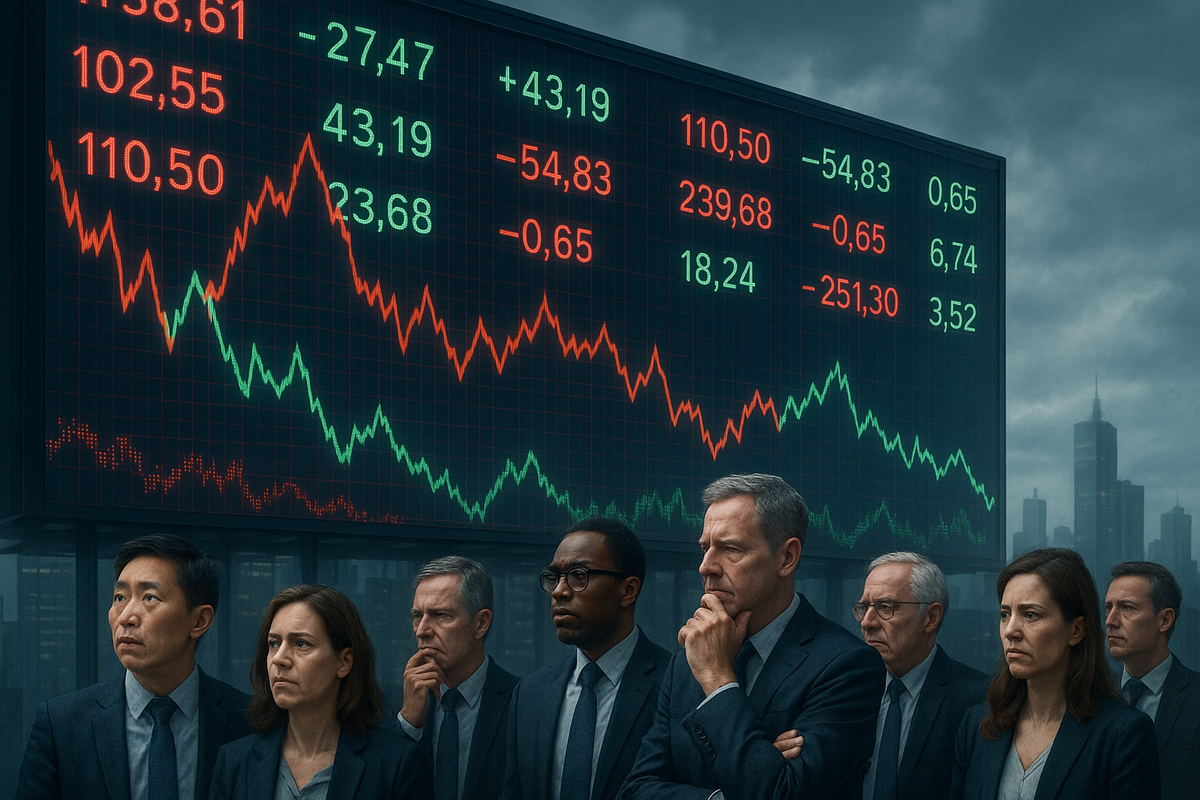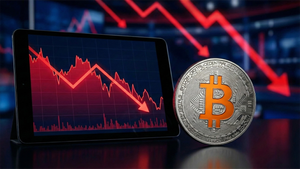
The U.S. stock market is currently navigating a turbulent August, characterized by significant volatility and sharp reversals. A confluence of factors, including escalating global trade tensions, weaker-than-expected economic indicators, and a mixed bag of corporate earnings reports, has sent major indices on a rollercoaster ride, leaving investors on edge. This period of heightened uncertainty aligns with historical trends that often mark August as a challenging month for equities, amplified by a surging CBOE Volatility Index (VIX).
What Happened and Why it Matters
The current market turmoil is primarily driven by three interconnected forces: the specter of new tariffs, disappointing economic data, and a corporate earnings season that has delivered both pleasant surprises and stark disappointments. These elements collectively paint a picture of an economy grappling with headwinds, prompting a re-evaluation of growth prospects and corporate profitability.
President Donald Trump's recent announcement of new tariffs on a wide array of goods from various trading partners has ignited significant uncertainty across global markets. Rates ranging from 10% to 50% have been imposed, notably including a 50% tariff on Brazil and 15% on the European Union, alongside new levies on India, Canada, Syria, and Taiwan. These tariffs, some of which took effect on August 7th, are already impacting pricing, with several sectors reporting increased operational costs. Tech giant Apple (NASDAQ: AAPL) has publicly warned that these new tariffs could lead to substantial cost increases, directly affecting their bottom line and potentially consumer prices.
Compounding the tariff concerns is a series of weaker-than-expected economic data releases. The Institute for Supply Management (ISM) Services PMI for July dipped to 50.1, a decline from 50.8 in June and falling short of the consensus forecast of 51.5. While still indicating expansion, this deceleration, coupled with a contraction in the employment index (46.4, down from 47.2), signals a softening demand environment and raises concerns about a potential economic slowdown in the latter half of the year. The report explicitly cited tariff-related impacts as a key driver of this slowdown. Furthermore, the July jobs report delivered a significant blow, with the U.S. economy adding only 73,000 jobs, far below the anticipated 106,000. This weak figure was exacerbated by substantial downward revisions of 258,000 jobs to the previous two months' data, marking the largest downward revision since 1979 outside of the pandemic. This alarming slowdown in the labor market has significantly bolstered the case for a September Federal Reserve rate cut, with market expectations for such a move surging to nearly 90%. The subsequent dismissal of the Bureau of Labor Statistics (BLS) chief following the report has also raised questions about the integrity and reliability of economic data.
The second-quarter corporate earnings season has presented a mixed bag, adding another layer of complexity to the market's current state. While over 80% of S&P 500 (SPX) companies that have reported have managed to exceed consensus estimates, indicating a degree of resilience, several high-profile disappointments have weighed heavily on investor sentiment. For instance, Amazon's (NASDAQ: AMZN) shares experienced a decline due to weaker-than-expected cloud growth, while Super Micro Computer (NASDAQ: SMCI) saw a significant plunge after reporting weaker results, explicitly citing higher costs stemming from tariffs. Conversely, companies like McDonald's (NYSE: MCD) and Shopify (NYSE: SHOP) have reported strong results, with Shopify notably stating that the impact of tariffs "did not materialize" for them. Overall, S&P 500 earnings for Q2 2025 are still expected to increase by a respectable 11.2% year-over-year, but the divergence in performance highlights the uneven impact of the current economic landscape.
Navigating the Crosscurrents: Winners and Losers in a Volatile Market
In this environment of heightened volatility, certain companies and sectors are proving more vulnerable to the prevailing headwinds, while others demonstrate surprising resilience or even capitalize on the shifting landscape. The impact of tariffs and economic slowdowns is creating a clear divide between potential winners and losers.
Companies with significant exposure to international trade and complex supply chains are bearing the brunt of the new tariff regime. As mentioned, Apple (NASDAQ: AAPL) has voiced concerns about substantial cost increases due which could impact their profitability and potentially lead to higher prices for consumers. Similarly, Super Micro Computer (NASDAQ: SMCI) directly attributed its weaker results to higher costs incurred from tariffs, illustrating the direct and immediate financial impact on businesses reliant on global sourcing and manufacturing. These companies, particularly those with operations heavily concentrated in regions targeted by new tariffs, face the challenge of either absorbing these increased costs, passing them on to consumers, or reconfiguring their supply chains – all of which can be costly and time-consuming endeavors. The manufacturing sector, in general, is likely to face increased pressure as raw material and component costs rise due to tariffs, potentially squeezing profit margins and dampening investment.
Conversely, companies with more localized supply chains, strong domestic demand, or those operating in sectors less directly impacted by trade disputes appear to be more insulated. McDonald's (NYSE: MCD), a global fast-food giant, reported strong results, suggesting that consumer spending on essential goods and services remains robust, even amidst broader economic concerns. Shopify (NYSE: SHOP), an e-commerce platform, also delivered positive earnings, noting that the anticipated impact of tariffs "did not materialize" for them. This suggests that businesses facilitating digital commerce, particularly those with diverse merchant bases and less reliance on direct import/export of physical goods, might be better positioned to weather the storm. Furthermore, sectors that benefit from a potential interest rate cut, such as real estate or certain growth-oriented technology companies, could see a boost if the Federal Reserve acts to stimulate the economy in response to the weakening jobs report.
The divergence in corporate performance underscores the importance of selective investment in a volatile market. Investors are increasingly scrutinizing company-specific fundamentals, supply chain resilience, and exposure to geopolitical risks. Companies with strong balance sheets, diversified revenue streams, and the agility to adapt to changing trade policies are likely to be the "winners" in this challenging environment, while those heavily reliant on uninterrupted global trade and facing significant cost pressures from tariffs may continue to struggle.
Industry Impact and Broader Implications
The current market volatility extends far beyond individual company balance sheets, rippling through entire industries and carrying broader implications for economic policy and global trade. This period of uncertainty is not an isolated event but rather fits into a larger narrative of increasing global trade protectionism and a potential slowdown in global economic growth.
The escalating trade tensions, particularly the imposition of new tariffs, are a significant part of broader industry trends towards deglobalization and the re-evaluation of international supply chains. Companies are increasingly considering diversifying their manufacturing bases away from heavily tariffed regions or even reshoring production to mitigate future trade risks. This could lead to a restructuring of global manufacturing and logistics, with long-term implications for shipping, raw material markets, and labor forces worldwide. Competitors and partners within affected industries will face similar pressures, potentially leading to a domino effect of cost increases, reduced demand, and altered competitive landscapes. For instance, industries reliant on imported components, such as electronics and automotive, will likely see increased production costs, which could be passed on to consumers or erode profit margins.
From a regulatory and policy standpoint, the weaker economic data, particularly the jobs report, has significantly increased the likelihood of a Federal Reserve interest rate cut in September. This potential monetary easing is a direct response to concerns about economic deceleration and could have a profound impact on borrowing costs, corporate investment, and consumer spending. The dismissal of the BLS chief following the jobs report also raises questions about government transparency and data integrity, which could further erode investor confidence and necessitate greater scrutiny of official economic indicators. Historically, periods of heightened trade tensions and economic uncertainty have often prompted central banks to adopt more accommodative monetary policies to support growth.
Comparing the current situation to historical precedents, August and September have traditionally been the weakest-performing months for U.S. equities. Since 1950, the S&P 500 has averaged a -0.7% return in September, making it the worst month on average. Over the past three decades, both August and September have seen average declines of 0.7% each. This seasonal weakness is often attributed to factors such as portfolio rebalancing, tax-loss selling by institutional investors, and reduced trading volume due to summer vacations. The current confluence of tariff concerns and weak economic data is amplifying this historical trend, making the market particularly susceptible to downturns. The significant increase in the CBOE Volatility Index (VIX), often referred to as the "fear gauge," to 20.38000 Index in August 2025, further underscores the heightened market uncertainty and the expectation of continued price swings. This rise in the VIX indicates that financial market volatility could persist for the remainder of the year, signaling a more challenging investment environment.
What Comes Next
The immediate future for the U.S. stock market appears to be one of continued vigilance and potential for further volatility. In the short term, market participants will be closely watching for any further developments on the tariff front, particularly the implementation and impact of the newly announced levies. Any signs of de-escalation or, conversely, further intensification of trade disputes will significantly influence market sentiment. The upcoming Federal Reserve meeting in September will be a pivotal event, with a high probability of an interest rate cut. The magnitude and language surrounding such a cut will be crucial in shaping market expectations for the remainder of the year.
In the long term, companies will need to strategically pivot and adapt to the evolving global trade landscape. This may involve accelerating efforts to diversify supply chains, exploring new markets, or even investing in automation and domestic production to reduce reliance on international trade. Businesses that can demonstrate agility and resilience in navigating these geopolitical and economic shifts will be better positioned for sustained growth. For investors, this period presents both challenges and opportunities. While the increased volatility necessitates a cautious approach, it also creates potential entry points for long-term investors seeking to acquire quality assets at more attractive valuations. Sectors that are less exposed to trade risks or those that stand to benefit from a potential interest rate cut, such as technology and healthcare, might offer relative stability.
Potential scenarios for the coming months include a continued "muddle-through" environment, where the market experiences intermittent rallies and pullbacks as it digests new information on trade and economic data. A more optimistic scenario could see a resolution or de-escalation of trade tensions, coupled with a more robust economic rebound, leading to a sustained market recovery. Conversely, a more pessimistic outlook involves a deepening of trade wars, a more pronounced economic slowdown, and potentially a recession, which would undoubtedly lead to further market declines. Investors should prepare for a range of outcomes and maintain a diversified portfolio, focusing on companies with strong fundamentals and a clear strategy for navigating the current economic climate.
Conclusion
The U.S. stock market's August volatility serves as a stark reminder of the intricate interplay between global trade policy, macroeconomic indicators, and corporate performance. The ongoing tariff concerns, coupled with weaker-than-expected economic data and mixed corporate earnings, have created a challenging environment for investors, pushing major indices into a period of significant fluctuation. The historical tendency for August and September to be weaker months for equities, amplified by a surging VIX, underscores the current market's susceptibility to external shocks and uncertainty.
Moving forward, the market will remain highly sensitive to developments on the trade front and future economic data releases. The Federal Reserve's response to the weakening economic indicators, particularly the likelihood of an interest rate cut, will be a critical factor in shaping market sentiment and liquidity. Investors should prioritize a comprehensive understanding of company-specific fundamentals, supply chain resilience, and exposure to geopolitical risks. Diversification across sectors and asset classes will be paramount in mitigating risk in this volatile environment.
Ultimately, the current market turbulence highlights the need for adaptability and a long-term perspective. While short-term swings may persist, the underlying strength of the U.S. economy and the innovative capacity of its corporations will be key determinants of future market performance. Investors should remain vigilant, focusing on quality investments and being prepared to adjust their strategies as new information emerges, recognizing that the current period of volatility may well set the stage for significant shifts in the financial landscape for the remainder of the year and beyond.




